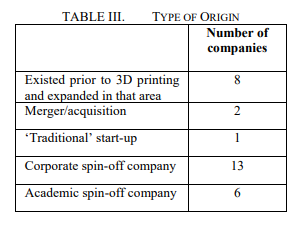It seems as though 3D printing is becoming pretty well-distributed around the world, as reports emerge of 3D printers being used even in remote communities and underdeveloped areas. However, when you look more closely, it turns out that 3D printing is fairly limited to a handful of countries, at least in terms of the production of 3D printers. In a study entitled “The Geography of 3D Printing,” a research team looks at the distribution of 3D printing companies around the world.
“The 3D printing industry is an interesting industry to study because the developments in this industry are happening while internet exists,” the researchers state. “This means that this is perhaps the first time in history that the global spread of innovation and the development of a high technology industry can be followed. Furthermore, since the industry is still relatively young, it can still be overseen in terms of the number of companies that are active.”
The researchers posed four questions related to the main companies that produce industrial 3D printers:
- Where were they founded? And, related to this, what is the national density for these companies?
- When were they founded?
- What led to the founding in that location?
- For academic spin-offs; to which universities does this relate and how are these ranked?
 The study shows that there is a high concentration of industrial 3D printer companies in the United States – particularly on the east coast – and Europe. A few companies exist in Asia, as well as one in Israel. No prominent 3D printer companies exist in Latin America, Africa or Australia. Interestingly, there is a lower number of companies in the Silicon Valley region than in the northeast US. The main companies studied were located in only 12 countries.
The study shows that there is a high concentration of industrial 3D printer companies in the United States – particularly on the east coast – and Europe. A few companies exist in Asia, as well as one in Israel. No prominent 3D printer companies exist in Latin America, Africa or Australia. Interestingly, there is a lower number of companies in the Silicon Valley region than in the northeast US. The main companies studied were located in only 12 countries.
“The comparison with the high-tech indicators ranking shows that many of the companies are based in countries that have been previously considered as having a high-tech standing,” the researchers add.
Note that this study is focused on the major producers of industrial 3D printers; there are additional early-stage, not-yet-established companies in many other locations such as Singapore, Taiwan and Switzerland.
60% of the companies studied were fewer than 20 years old, while 30% of them were 10 or fewer years old. This is unsurprising, as 3D printing is still a relatively new industry. It has been in existence since the 1980s, but has only truly picked up steam, so to speak, in the last couple of decades.
When looking at the 30 major producers of industrial 3D printers, five categories emerged:
- Companies that existed before 3D printing and only adopted it later, such as HP
- Companies that were founded as a merger between two other companies with knowledge of 3D printing, such as AddUp
- Traditional startups
- Corporate spinoffs
- Academic spinoffs
About 20% of the companies studied were academic spinoffs, and nearly half were formed as corporate spinoffs.
 According to the researchers, there are several implications from the study’s findings. First, companies that are already active within the industry are going to be faced with additional competitors, and it is likely that these companies will be corporate or academic spinoffs. Secondly, for both existing companies and new entrants to the industry, it is important to think about technology acquisition.
According to the researchers, there are several implications from the study’s findings. First, companies that are already active within the industry are going to be faced with additional competitors, and it is likely that these companies will be corporate or academic spinoffs. Secondly, for both existing companies and new entrants to the industry, it is important to think about technology acquisition.
“Third, related to the geographic component, the acquisition of technology may also come from universities,” the researchers conclude. “The study provides some insight into universities that have a played a role…However, this is a very limited set and companies should look at other top-ranked universities for research that may lead to additional consequences or technology acquisition opportunities in 3D printing.”
Authors of the paper include Harm-Jan Steenhuis, Xin Fang, and Tolga Ulusemre.
Discuss this and other 3D printing topics at 3DPrintBoard.com or share your thoughts below.
Subscribe to Our Email Newsletter
Stay up-to-date on all the latest news from the 3D printing industry and receive information and offers from third party vendors.
You May Also Like
3D Printing News Briefs, April 13, 2024: Robotics, Orthotics, & Hypersonics
In 3D Printing News Briefs today, we’re focusing first on robotics, as Carnegie Mellon University’s new Robotics Innovation Center will house several community outreach programs, and Ugogo3D is now working...
Rail Giant Alstom Saves $15M with 3D Printing Automation Software 3D Spark
3D Spark has entered into a three-year deal with the rail giant Alstom. Alstom, a transport behemoth with annual revenues of $16 billion, specializes in the manufacture of trains, trams,...
Meltio Expands Global Reach with New Partnerships in the Americas and Europe
Spanish 3D printing manufacturer Meltio has expanded its sales network across the globe. With the addition of three new partners in the United States, Brazil, Argentina, and Italy, Meltio aims...
3D Printing Webinar and Event Roundup: April 7, 2024
Webinars and events in the 3D printing industry are picking back up this week! Sea-Air-Space is coming to Maryland, and SAE International is sponsoring a 3D Systems webinar about 3D...
































